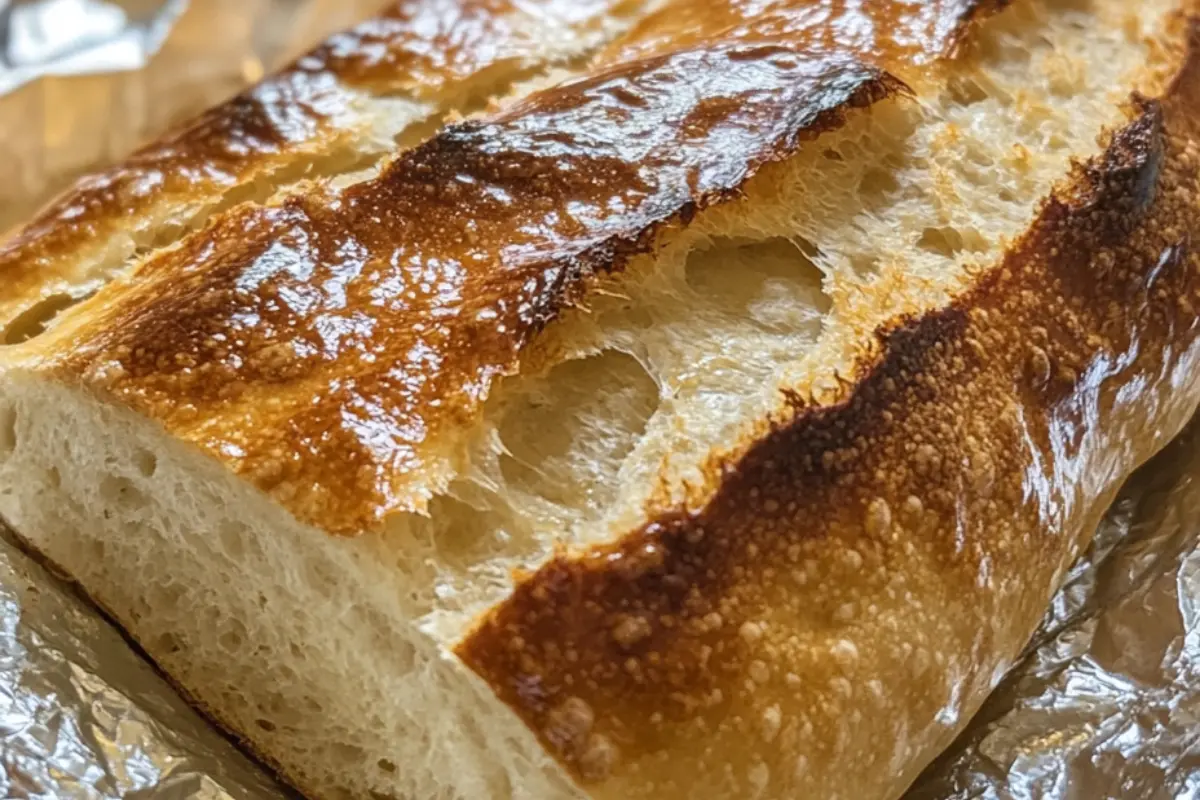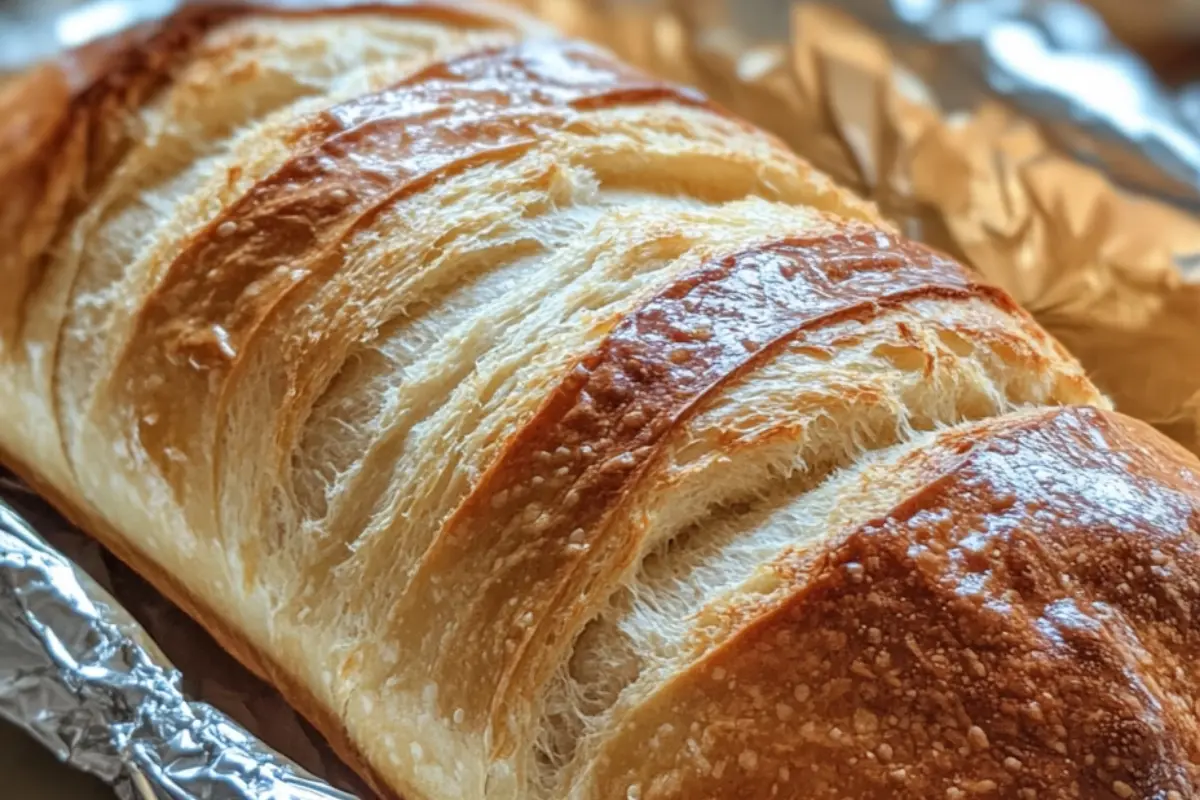
What is Sourdough Bread?
Sourdough bread is a type of bread made using a natural fermentation process. Unlike commercial breads that rely on store-bought yeast, sourdough uses wild yeast and lactic acid bacteria found in flour. This traditional method not only gives sourdough its unique tangy flavor but also makes it easier to digest.
The history of sourdough bread dates back thousands of years, with evidence of its use in ancient Egypt. Today, it’s celebrated worldwide for its rustic appearance, chewy texture, and complex taste. Beyond its delightful flavor, sourdough holds a special place in many cultures as a symbol of home baking and artisanal craftsmanship.
The Science Behind Sourdough Bread
How Sourdough Bread Ferments
Fermentation is the heart of sourdough bread making. It involves a symbiotic relationship between wild yeast and lactic acid bacteria.
The Role of Wild Yeast: Sourdough Bread
Wild yeast is naturally present in the environment and can be found on flour. When combined with water, it begins to feed on the sugars in the flour, producing carbon dioxide and alcohol. This process is what makes the dough rise.
The Importance of Lactic Acid Bacteria: Sourdough Bread
Lactic acid bacteria work alongside wild yeast, breaking down complex carbohydrates into simpler compounds. This not only contributes to the bread’s tangy flavor but also improves its nutritional profile by making nutrients more accessible.
Fermentation Process Explained: Sourdough Bread
During fermentation, the dough undergoes a series of chemical reactions. Enzymes break down starches into sugars, which the yeast and bacteria consume. The byproducts of this process—carbon dioxide, lactic acid, and alcohol—create the bread’s texture, flavor, and rise. The fermentation time and temperature can significantly affect the flavor and texture of the final loaf. Cooler temperatures result in a slower fermentation, which can enhance the complexity of flavors, while warmer temperatures speed up the process, producing a milder taste.
Making Your Own Sourdough Starter
How Do You Make Sourdough Starter from Scratch?
A sourdough starter is a living culture of flour and water, inhabited by wild yeast and lactic acid bacteria. It acts as the natural leavening agent for sourdough bread.
Ingredients Needed
To make a sourdough starter, you’ll need:
- Whole wheat or rye flour
- Water (preferably filtered)
Step-by-Step Process: Sourdough Bread
- Day 1: In a clean jar, mix 50 grams of whole wheat flour with 50 grams of water. Stir well, cover loosely, and let it sit at room temperature. This mixture should have the consistency of thick pancake batter.
- Day 2: Discard half of the starter. Add 50 grams of all-purpose flour and 50 grams of water to the remaining mixture. Stir well, cover, and let sit. You may start to see some bubbles, indicating fermentation has begun.
- Days 3-7: Repeat the Day 2 process daily. Each day, you should see more bubbles and a noticeable rise and fall in the mixture, which means the yeast is active and healthy. By the end of the week, your starter should be bubbly and have a pleasant, slightly tangy smell.
Maintaining Your Sourdough Starter
Once established, maintain your starter by discarding half and feeding it with equal parts flour and water every day. If baking less frequently, you can store it in the fridge and feed it once a week. Remember to let it come to room temperature and feed it a few times before baking.
Baking Sourdough Bread
Essential Ingredients and Tools
Making sourdough bread requires a few key ingredients and tools.
Flour Types and Their Effects
The type of flour you use can significantly impact your sourdough. High-protein flours like bread flour produce a strong, elastic dough, while whole grain flours add flavor and nutrition. Rye flour, for instance, can enhance the sourness of the bread due to its high enzyme activity. Experimenting with different flour combinations can yield varying textures and flavors.
Necessary Baking Equipment
- A digital kitchen scale for precise measurements.
- Mixing bowls of various sizes.
- A bench scraper for handling dough.
- Proofing baskets (bannetons) for shaping and rising the dough.
- A Dutch oven or baking stone to create a steamy baking environment.
- A lame or sharp knife for scoring the dough to control the rise and create beautiful patterns.
Step-by-Step Sourdough Bread Recipe
Mixing the Dough
Combine your active starter, flour, and water. Mix until a rough dough forms. Let it rest for 30 minutes. This rest period, known as autolyse, helps to hydrate the flour and start the gluten development process.
Kneading and Folding Techniques
Instead of traditional kneading, use the stretch and fold method. Over the next few hours, stretch the dough and fold it over itself every 30 minutes. This gentle technique strengthens the dough without overworking it, leading to an open crumb structure.
Proofing and Shaping the Dough
After the final fold, let the dough rise until it has doubled in size. This first rise, or bulk fermentation, can take several hours depending on the temperature and activity of your starter. Shape it into a tight ball and place it in a proofing basket. For the final proof, the dough can be left at room temperature for a few hours or refrigerated overnight to develop more flavor.
Scoring and Baking Your Bread
Preheat your oven with a Dutch oven inside. Transfer the dough to the Dutch oven, score the top, and bake covered for 20 minutes. Remove the lid and bake until golden brown. The initial covered baking period creates steam, which helps the bread rise and develop a crispy crust.
Health Benefits of Sourdough Bread
What Makes Sourdough Bread Healthier?
Sourdough bread offers numerous health benefits, making it a preferred choice for many health-conscious individuals.
Nutritional Profile
Sourdough bread is rich in vitamins and minerals. The fermentation process breaks down phytic acid, which can inhibit the absorption of essential nutrients like zinc, iron, and magnesium. This makes the nutrients in sourdough more bioavailable compared to other breads. Additionally, sourdough can contain more antioxidants and lower levels of harmful substances like acrylamide.
Digestive Benefits
The natural fermentation process in sourdough breaks down gluten, making it easier to digest for people with mild gluten sensitivities. Additionally, the lactic acid bacteria in sourdough produce probiotics, which can contribute to a healthy gut microbiome. This can improve overall digestion and reduce inflammation.
Lower Glycemic Index
Sourdough bread has a lower glycemic index compared to regular bread. This means it causes a slower, more gradual rise in blood sugar levels, which can be beneficial for people with diabetes or those looking to manage their blood sugar levels. The lactic acid bacteria lower the rate of starch digestion, making sourdough a better choice for sustained energy release.
Storing and Using Sourdough Bread
How Long Does Sourdough Bread Last?
Sourdough bread, when stored properly, can last longer than conventional bread due to its natural acidity, which inhibits mold growth.
Best Practices for Storing Sourdough
To keep your sourdough fresh, store it at room temperature in a bread bag or wrapped in a clean kitchen towel. Avoid using plastic bags, as they can cause the crust to become soft and chewy. A bread box is also an excellent option for maintaining a crisp crust while keeping the interior moist.
Freezing and Reheating Tips
For longer storage, you can freeze sourdough bread. Slice it first, then wrap each slice in plastic wrap and place in a freezer bag. To reheat, simply toast the slices or warm them in an oven at 350°F (175°C) for about 10 minutes. This method helps retain the bread’s texture and flavor.
Creative Uses for Stale Sourdough Bread
Stale sourdough can be repurposed in various delicious ways. Make croutons by cutting the bread into cubes, tossing with olive oil and seasonings, and baking until crispy. Bread pudding is another classic dish that transforms stale bread into a decadent dessert. You can also use it in recipes that call for breadcrumbs, like meatballs or gratins. To revive stale bread, sprinkle it with water and heat it in the oven for a few minutes.
Troubleshooting Common Issues
Common Problems and Solutions
Even seasoned bakers encounter issues when making sourdough. Here are some common problems and how to fix them.
Why Didn’t My Dough Rise?
If your dough didn’t rise, it might be due to an inactive starter or a too-cool environment. Ensure your starter is bubbly and active before using it, and let the dough rise in a warm place. If the temperature is too low, fermentation will slow down. Aim for a consistent room temperature of around 75°F (24°C) for optimal rising.
Fixing Overproofed Dough
Overproofed dough can become too weak to hold its shape. To fix this, gently reshape the dough and let it rise again, but for a shorter time. Overproofing occurs when the dough has fermented for too long, causing the gluten structure to weaken. Monitor the dough closely and perform a “poke test” – if the indentation springs back slowly, it’s ready to bake.
Dealing with a Dense Crumb
A dense crumb can result from under-kneading or insufficient fermentation. Ensure you knead the dough adequately and give it enough time to ferment and develop structure. Additionally, make sure your starter is strong and active. A weak starter can lead to poor rise and dense bread.
FAQs About Sourdough Bread
Frequently Asked Questions
How Do You Make Sourdough Starter from Scratch?
To make a sourdough starter from scratch, mix equal parts whole wheat flour and water, and feed it daily until it becomes bubbly and active. Consistency is key – feed your starter at the same time each day and keep it at a stable temperature.
What Makes Sourdough Bread Healthier?
Sourdough bread is healthier due to its easier digestibility, lower glycemic index, and higher bioavailability of nutrients. The fermentation process breaks down complex carbohydrates and gluten, making sourdough a gentler option for many people.
How Long Does Sourdough Bread Last?
Sourdough bread can last several days at room temperature if stored properly and can be frozen for longer preservation. The natural acidity of sourdough helps it resist mold, extending its shelf life compared to other breads.
What is the Best Flour for Sourdough Bread?
Bread flour is ideal for sourdough due to its high protein content, but whole grain flours can add flavor and nutrition. Experiment with different flours to find your preferred taste and texture. For instance, incorporating rye or spelt flour can add depth and complexity to your sourdough.
Conclusion
Enjoying Your Homemade Sourdough Bread
Making sourdough bread is a rewarding process that combines science, art, and a touch of tradition. From creating your own starter to baking the perfect loaf, each step is a journey toward delicious, healthy bread. Don’t be afraid to experiment with different flours and techniques to find what works best for you. Happy baking!
Takeaways:
- Sourdough bread is made using natural fermentation with wild yeast and lactic acid bacteria.
- Making and maintaining a sourdough starter requires daily feeding and attention.
- Sourdough offers health benefits, including easier digestibility and a lower glycemic index.
- Proper storage can extend the freshness of sourdough bread.
- Troubleshooting common issues can improve your baking results.
What’s your favorite way to enjoy sourdough bread? Share your tips and recipes in the comments below!





